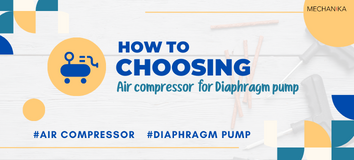Choosing air compressor for diaphragm pump involves considering several factors to ensure efficient and reliable operation. Diaphragm pumps are positive displacement pumps that use reciprocating motion to move fluids. The air compressor you choose should provide the necessary air pressure and flow rate to operate the diaphragm pump effectively. Here’s a step-by-step guide to help you choose the right air compressor:
Choosing Air Compressor for Diaphragm Pump
- Determine Air Pressure Requirements: Check the specifications of your diaphragm pump to find out its required operating air pressure. This is typically measured in pounds per square inch (psi) or bar. Make sure the air compressor you choose can provide this pressure consistently.
- Calculate Air Flow Rate: Find out the required air flow rate (usually expressed in cubic feet per minute, CFM, or liters per minute, LPM) for your diaphragm pump to function optimally. This information can usually be found in the pump’s technical documentation. It’s crucial to choose an air compressor that can supply the necessary flow rate to keep the pump running smoothly.
- Consider Duty Cycle: The duty cycle refers to the percentage of time the pump will be running. If the diaphragm pump will be operating continuously or for extended periods, you’ll need an air compressor with a higher duty cycle to ensure it can sustain the required air pressure and flow without overheating.
- Check for Compressor Type: There are different types of air compressors, including reciprocating (piston), rotary screw, and centrifugal compressors. For diaphragm pumps, reciprocating and rotary screw compressors are commonly used due to their ability to provide steady pressure and flow. Choose the type that best suits your requirements and budget.
- Consider Power Source: Determine whether you need an electric or gas-powered air compressor based on your operating environment and available power sources. Electric compressors are common for indoor settings, while gas-powered compressors are suitable for outdoor or remote locations.
- Tank Size: The air compressor’s tank size is important if your diaphragm pump requires a consistent air supply. A larger tank can help provide a buffer of stored air to accommodate fluctuations in demand without putting excess strain on the compressor.
- Account for Pressure Regulation: Diaphragm pumps may require precise air pressure regulation for optimal performance. Make sure the chosen air compressor has built-in pressure regulation features or consider installing an additional pressure regulator in the air line.
- Consider Noise Levels: Depending on your operating environment, noise levels can be a concern. Look for air compressors with noise-reduction features or enclosures if noise is an issue.
- Maintenance and Reliability: Research the maintenance requirements and reliability of the air compressor brands and models you’re considering. A reliable compressor will ensure consistent performance and minimize downtime.
- Consult with Experts: If you’re unsure about the specific requirements for your diaphragm pump and air compressor, consider consulting with a pump or compressed air system expert. They can provide valuable insights based on their experience and knowledge.
Remember that the key is to match the air compressor’s pressure and flow capabilities with the requirements of your diaphragm pump. Taking the time to select the right air compressor will lead to smoother operations and improved efficiency.
TEL 02-011-1000 , Hotline 088-008-2305
YOUTUBE : MECHANIKA

